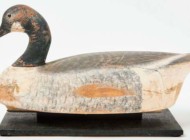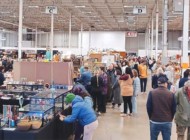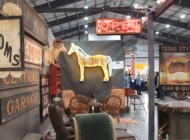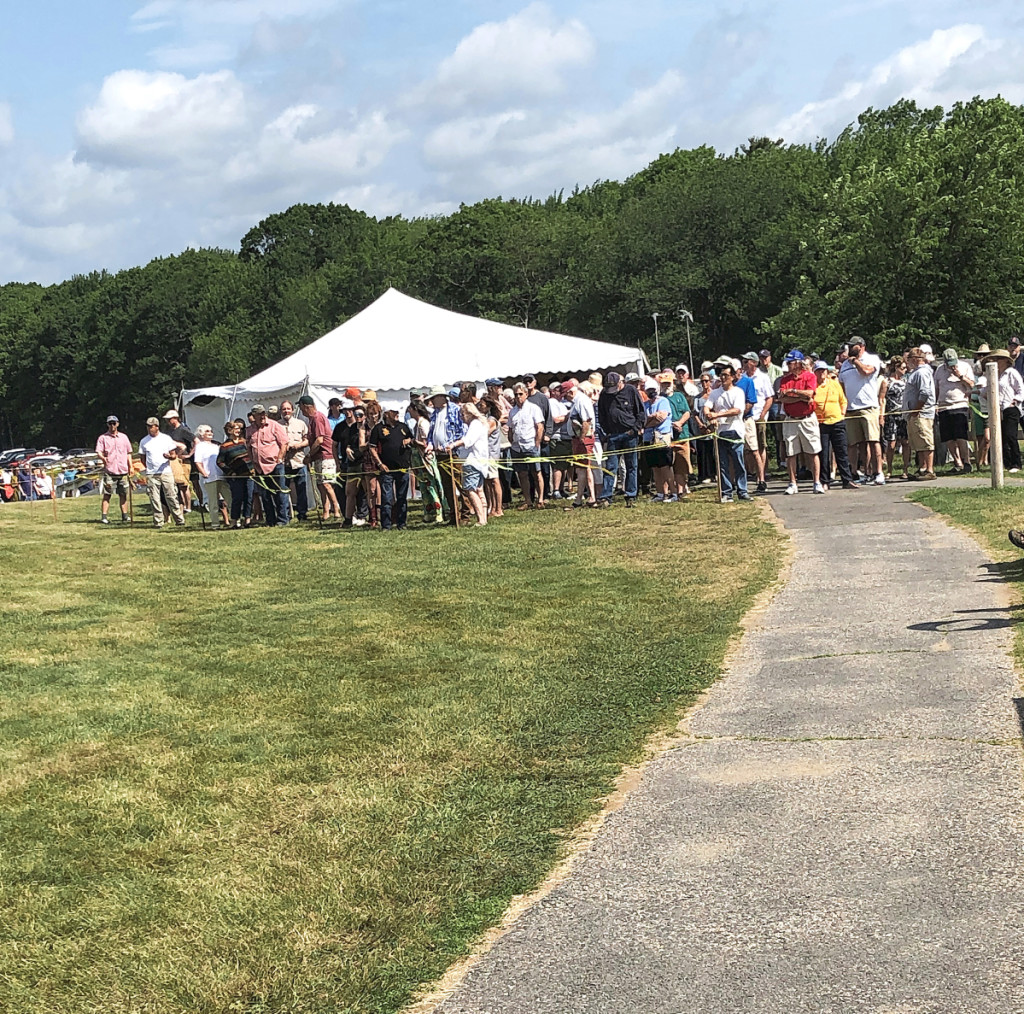
John DeSimone said that more than 500 people came through the gate in the first hour of the show. This photo shows only a portion of those lined up prior to the opening.
Review and Photos by Rick Russack
WELLS, MAINE – The Wells show is one of the staples of the circuit of outdoor summer shows in Maine. Run by Liz and John DeSimone’s Goosefare Promotions, the show is now in its 20th year. It has about 70 exhibitors and draws a large crowd. Attendance this year far exceeded previous shows, probably because buyers and sellers are ready for life returning to normal. It’s basically an Americana show, but there’s plenty of other material.
Expect to find folk art, Eighteenth and Nineteenth Century furniture, early lighting, trade signs, stoneware and redware, Native American material, quilts, baskets and paintings. You would also have found jewelry, vintage clothing, Staffordshire, delft and Chinese export porcelains, art pottery and midcentury studio pottery, along with one-of-a-kind items and rarities. There were several dealers new to the show this year. It’s conducted on the grounds of the Wells Reserve at Laudholm Farm, a National Estuarine Reserve with plenty of nature trails through woodlands and wetlands for those inclined to explore a little after the show.
Folk art is a staple and this year’s offerings ranged in size from an enormous plover decoy sign more than 4 feet tall to fish decoys that were approximately 3 or 4 inches in length. Jewett-Berdan Antiques, New Castle, Maine, priced their large plover $950. There were numerous duck decoys and decorative carvings, plus at least one large swan decoy in the booth of Stephen-Douglas Antiques, which was priced $1,200.
Hannah Humes, an Ohio dealer, had a stack of Nineteenth Century wallpaper covered boxes priced between $795 and $995. Weathervanes were available in at least a half dozen booths and several sold. Perhaps weathervane interest has been increased by the publicity in this publication, as well as others, given to the current show at the American Folk Art Museum, “American Weathervanes: The Art of The Winds.”
Selections of fish decoys were available in several booths, a little surprising since they were primarily used in Minnesota, Wisconsin and Michigan. Ed Holden, Holden Antiques, Sherman, Conn., and Naples, Fla., said that most states have outlawed the use of these decoys. New York made them illegal in 1906. Their use was permitted, however, during the lean years of the Depression. His decoys were priced between $80 and $125. Holden also had two multi-pronged hand forged fish spears. The idea was that the decoys would be used to lure the fish to the surface where they would then be speared. Jim and Nancy Glazer, Bailey Island, Maine, also had several examples, including a large sturgeon decoy that was priced $450. Decoys made by Oscar Peterson (1887-1951), the acknowledged “master” of the field, often bring five-figure prices. Two major decoy auctions this summer will include examples of his work.
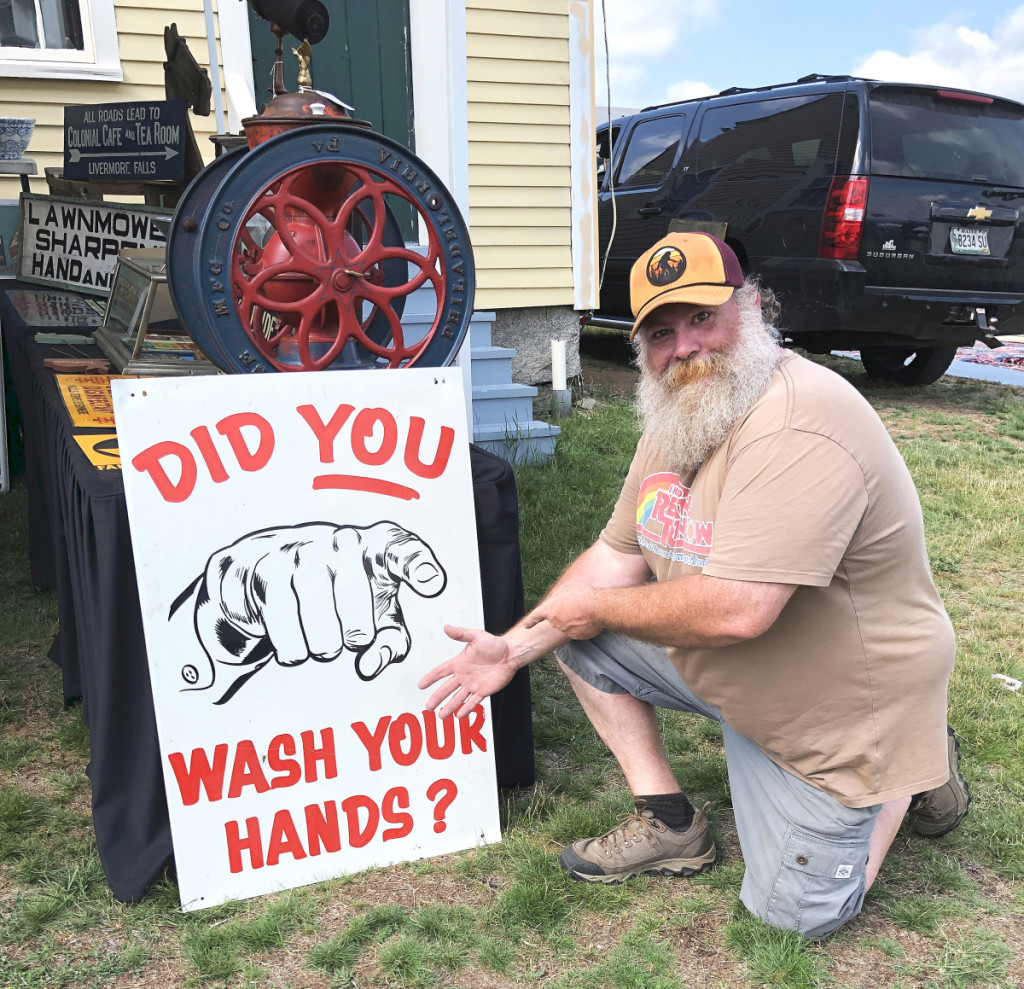
John Lord, Antiques and Tyme, Wells, Maine, had about 60 or 70 trade signs. This one is particularly appropriate to the times and was priced $300.
Bob Markowitz, Groveland, Mass., is one of the dealers who thoroughly researches the items he is selling. Priced at $850 was a three-dimensional Moravian ribbon-work memorial with colorful, raised flowers. In the center, painted on bone, was a small traditional mourning scene of a weeping willow. Markowitz said that the foliage of the weeping willow was human hair, most likely that of the deceased. It was dated 1832. Students attending the Young Ladies Seminary in Salem, N.C., are known to have created this type of memorial, but it is not known if this one came from that school. He also had an unusual “woolie.” Most show marine subjects; this one depicted a steam locomotive and tender, with the logo of the Great Eastern Railroad. Markowitz was curious to see if he could learn the exact date it was created and contacted the Great Eastern Railway Society. It was determined that the particular locomotive shown in the “woolie” dated to 1895. It was priced $700.
In addition to the redware and stoneware offered in several booths, there was also some unusual Bennington, or perhaps more accurately, Rockingham, to be seen. Mario Pollo had a large, mottled, bovine with prominent horns. It was not marked and was priced at $1,250. Josh Farrin, Randolph, Maine, had an unusual, large covered jar with molded heads and large handles. The price was $450.
Some outdoor shows do not have a lot of furniture, especially painted country pieces. This one did. Hilary Nolan had several pieces, as did Ian McKelvey, Josh Farrin, Bob Markowitz, Benting & Jarvis, Heller Washam Antiques, Stephen-Douglas Antiques, Bill Kelley, Harry Hepburn and several others. Formal furniture was available from Martin Ferrick, Morgan MacWhinnie (who was new to the show) and others.
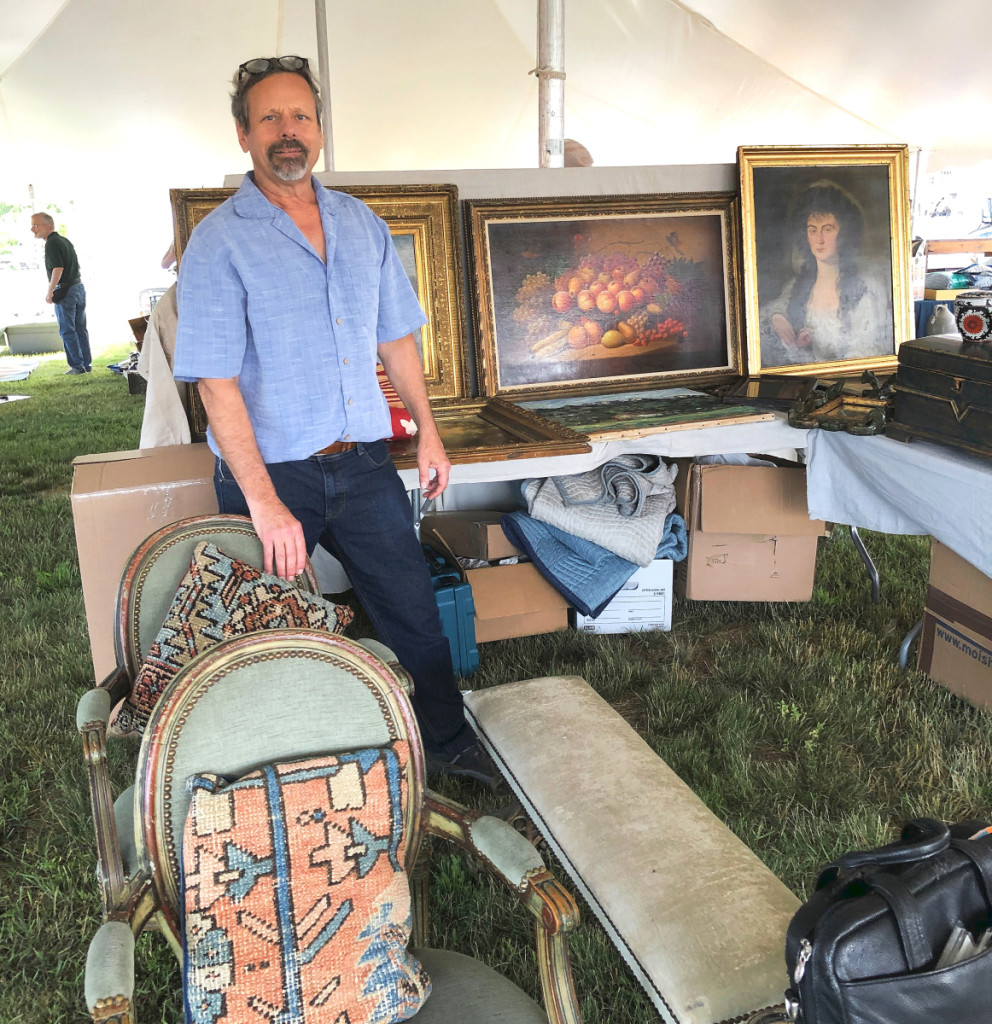
Mario Pollo, Bearsville, N.Y., had an assortment of paintings, outdoor items and even a silver-trimmed Western parade saddle, which was priced $750.
More and more midcentury studio pottery is appearing at country shows. Deirdre O’Callaghan, Partridge Hill Antiques, said she has been collecting Anderson pottery, produced in nearby East Boothbay, Maine, for several years. The studio was in business from 1952 until just recently. She said, “I really like the things they produced but it’s time for me to downsize.” She had four pieces priced between $60 and $150. John Prunier had an exceptional mosaic wall tile made by David Holleman (b 1927), circa 1950s-60s. It depicted a mythological figure and was priced $550. Holleman worked in the Boston area and his work is in the National Gallery and numerous other museum collections.
After the show, John DeSimone was a very happy show promoter, saying, “Everything came together for this show. It was the best Wells show we’ve ever had. Weather was perfect, the crowd was huge – we almost ran out of parking space – and dealer sales were steady all day. I saw several pieces being hauled off, and a number of customers pulled cars around back to a loading area. Early forecasts had included rain, so we added an extra-large tent so we could get as many people under cover as possible. Dealers told us they had good a show, and it was a very good feeling for Liz and me after the experiences of the last year.”
For information, 800-641-6908 or www.goosefareantiques.com.

























